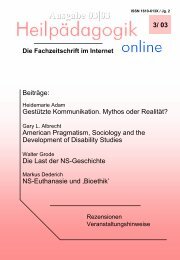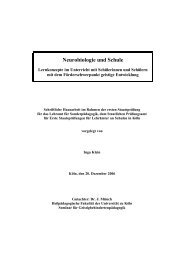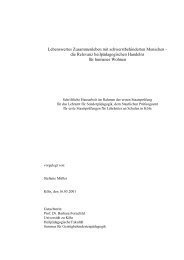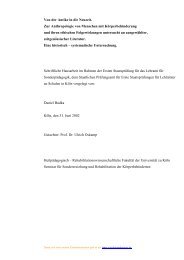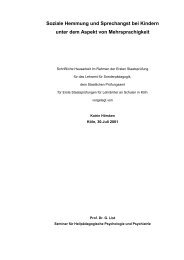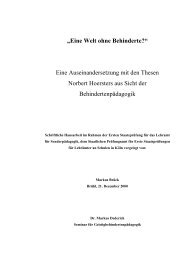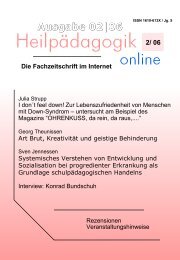Erste Schritte in die Physik für Gehörlose - sonderpaedagoge.de!
Erste Schritte in die Physik für Gehörlose - sonderpaedagoge.de!
Erste Schritte in die Physik für Gehörlose - sonderpaedagoge.de!
Erfolgreiche ePaper selbst erstellen
Machen Sie aus Ihren PDF Publikationen ein blätterbares Flipbook mit unserer einzigartigen Google optimierten e-Paper Software.
Madness and Disabilities: Interview with Geoffrey Reaume<br />
which needs to be acknowledged. Historically, psychiatric patients<br />
throughout the western world built, ma<strong>in</strong>ta<strong>in</strong>ed and cleaned asy-<br />
lums for no pay un<strong>de</strong>r the guise of moral therapy. The i<strong>de</strong>a was<br />
that light work and leisure activities could help to regulate and con-<br />
ciliate a troubled m<strong>in</strong>d. The reality was that this work was frequent-<br />
ly very heavy and anyth<strong>in</strong>g but light - build<strong>in</strong>g brick walls was not<br />
an easy task, after all. The history beh<strong>in</strong>d these walls reflect the<br />
immense toil that patients <strong>in</strong> the Toronto Asylum did, both men and<br />
women, for which they were never paid and have generally not<br />
been acknowledged, reflect<strong>in</strong>g the hid<strong>de</strong>n labour history of people<br />
with disabilities. This history has had immense impact on public<br />
policies down to today with very high unemployment rates among<br />
people with disabilities and people with a psychiatric history <strong>in</strong> par-<br />
ticular which has sought to justify <strong>de</strong>valu<strong>in</strong>g their work by claim<strong>in</strong>g<br />
it was not reliable or valuable work. Yet, my research on labour at<br />
this former asylum <strong>in</strong> 19th century Ontario shows just the opposite<br />
- after all, how much more reliable can you get than build<strong>in</strong>g brick<br />
walls <strong>in</strong> what is now a very busy part of Toronto that has lasted <strong>in</strong><br />
one case for 148 years and <strong>in</strong> another case for 120 years. These<br />
walls reflect immense prejudice towards the people who built them<br />
where their labour was never properly compensated, and it also re-<br />
flects much pri<strong>de</strong> <strong>in</strong> their abilities which many of us <strong>in</strong> the psychi-<br />
atric survivor community have sought to have recognized <strong>in</strong> recent<br />
years through wall tours, campaigns for plaques and various public<br />
education efforts. To see more about efforts to preserve this histo-<br />
ry, please see my article <strong>in</strong> the Disability History Association<br />
newsletter, fall 2006 at the follow<strong>in</strong>g l<strong>in</strong>k:<br />
http://dha.osu.edu/news/fall06/newsfall06.html<br />
Heilpädagogik onl<strong>in</strong>e: If you look at the category "madness" as a<br />
historian, what can you say about psychiatric disabilities today?<br />
- 59 -<br />
Heilpädagogik onl<strong>in</strong>e 04/ 08



